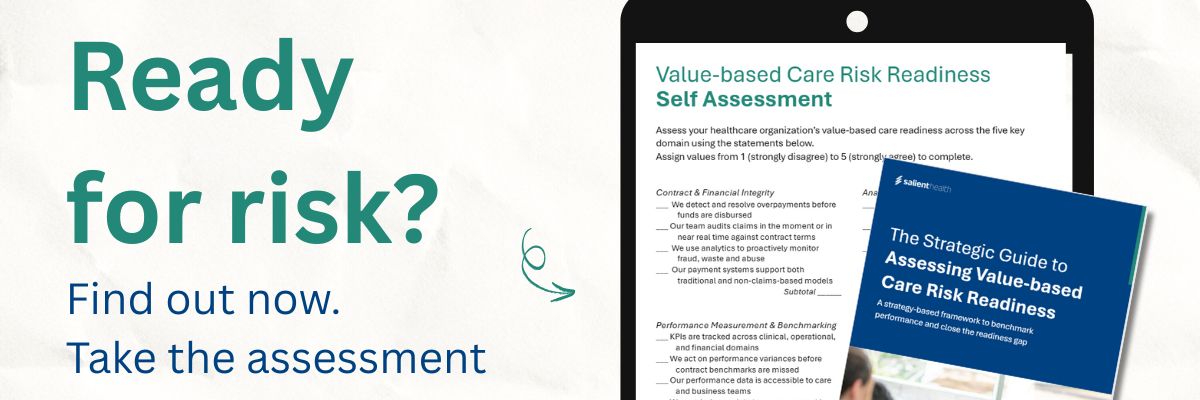So you have the data… but can actually make sense of it all?
As value-based care evolves and healthcare organizations continue to adapt, it’s time to rethink how we define success. In theory, it’s simple: get paid for delivering more favorable outcomes at a lesser cost. However, in practice, the reality is quite different.
CINs, IPAs, PHOs and ACOs contend with attribution volatility, rising administrative burden and performance models that constantly evolve. This means that not only are financial incentives always on the line, so is your organization’s reputation.
The ability to use data effectively sets high-performing value-based organizations apart from others. And it’s not just the use of any data, the way these organizations leverage intelligence from their claims data is telling.
Despite years of investment in data warehouses, dashboards and reporting tools, many organizations still treat claims as a passive record of what happened. The retrospective review needs to shift. Claims data, when properly leveraged, can be one of the most powerful tools in your value-based arsenal. It reveals who’s at risk, where you’re leaking patients and performance and how to intervene before costs climb or quality slips.
Without claims intelligence, your organization is simply flying blind.
“We have enough data.” Fact? Myth?
Healthcare isn’t short on data. You have multiple systems and multiple data sets from one department alone. Compound that across your organization and the sheer amount of data you have is overwhelming.
Most organizations can call upon IT or analysts to create dashboards, pull lagging indicators or review reports; however, it’s all retrospective. There’s a distinct difference between access and action, between simply having claims data and understanding the state of your exposure to risk.
Claims often sit in disconnected silos. Pulled for quarterly reviews, payer audits or after the contract year is over, they’re regarded as a source of truth, not as a source of guidance.
This is where the real risk lies. Value-based care is dynamic, requiring proactive management. And if the insights needed to manage performance in real time aren’t visible to those making decisions, results will suffer.
The story claims data tells
When claims data is analyzed and interrogated through the right lens, it reveals more than just care service history. Claims data shows the health of your clinical and operational performance, population behavior and how care is delivered across settings.
These critical signals can be found in claims data:
- Network Leakage
Are your attributed patients receiving care outside your healthcare ecosystem? Claims data shows how often patients leave your network, where they receive treatment and what services they seek when doing so. This isn’t just a referral management problem, it’s a financial drain and a missed opportunity to coordinate care.
- Unmanaged Risk
Utilization patterns can flag at-risk patients before clinical records do. Frequent ED visits, prescription refills without follow-ups and repeated diagnostics indicate gaps in care that claims can reveal before most clinical systems have the capability to.
- Denials and Inefficiencies
Every denial has a root cause. Claims analysis shows you which payers push back, which codes trigger rejection and where documentation or billing processes fall short. Insight into these scenarios directly affect cash flow and quality performance, two major components to success in the value-based care model.
- Failure to Close Gaps
Care gaps aren’t always clinical. They can be operational in nature as well. Claims can tell you how long it takes for high-risk patients to receive a visit, cadence for follow-ups or if chronic condition management occurs with an appropriate frequency.
The leadership blind spots
Executives often assume that if performance is off, the issue lies in execution. They may cite a lack of engagement with patients on the part of care teams, missed follow-ups with administrators or slow response times. The problem, however, often lies upstream: a lack of access to the right data in the right format at the right time.
Traditional BI tools weren’t designed for value-based care. These business intelligence tools and even some payer portals, fail to reflect the dynamic attribution models, contractual logic and cohort-specific performance metrics that define value-based care success. They’re slow, rigid and detached from the clinical-operational-financial triad that VBC demands.
Misalignment of this sort results in:
- Lagging decisions based on outdated reporting or dashboards
- Inaccurate assumptions about cost and utilization drivers
- Reactive strategies instead of proactive interventions
- Lack of visibility for care teams relating to at-risk patients
You can’t manage what you can’t see. When performance can’t be understood, analyzed or measured in the moment, you assume the risk of falling behind.
From attribution to accountability
Every value-based care contract starts with attribution. But is that really the starting point? The ability to act and know where to start with care is what really determines success.
Out of a cohort of Medicare beneficiaries, are you able to ascertain which are high-risk or rising risk to create proper plans? Can you identify the patients with gaps in care that actively risk your HEDIS performance? Which are likely to use the ED in the next 60 days? Which providers deliver high-cost, low-value services within your own network?
These answers don’t live in your EHR. Nor will you get them from payer scorecards months after the fact. The answers to these questions are found specifically in your claims data.
But, you don’t know how or where to look, you’ll miss early warning signs, burn through shared savings and lose ground on quality benchmarks that directly affect your reimbursement and risk adjustment.
How high-performing healthcare organizations use claims data
Salient Health works with organizations that treat claims as a strategic asset, not a reporting obligation. Claims intelligence embedded directly into daily workflows builds systems that surface insights automatically, not through tickets to IT or quarterly data pulls.
With embedded intelligence, organizations create scenarios that look like:
- Patient priority based on real-time claims triggers
- Proactive monitoring of risk corridors and contract performance
- Operational efficiencies based on availability to optimize downstream utilization
- Executive-level insight into past, current and projected performance, including leakage and utilization trends
Value-based care fails when leaders can’t anticipate what’s next. They fly blind, making decisions based on retrospective reporting, siloed, half data truths and improperly segmented analytics.
Don’t wait for missed benchmarks, lost savings or attribution losses to show you where the problems are. Use the data you already have, the data you’re already paying for, to take control of performance before it’s too late.





